#Richard was the Duke of Suffolk
Explore tagged Tumblr posts
Text
I can’t believe it took me until last night to realize why Perrin Fertha and Davo Sculdun looked so familiar to me.
They were both members of Henry VIII’s sleazy entourage in Wolf Hall.
#Andor#Perrin Fertha#Davo Sculdun#Wolf Hall#Alastair Mackenzie#Richard Dillane#Richard was the Duke of Suffolk#and Alastair was Brereton#who I thought was quite hot in a douchebag sort of way#back in my Wolf Hall obsession days
6 notes
·
View notes
Text
We are now truly diving into the mad historical hypotheticals folks:
For this hypothetical we are just dealing with the shark from the first Jaws movie. Just a regular old killer shark.
I don’t have any proper rules for this one. Just they’re on a boat and have to survive and/or kill Jaws.
#tumblr polls#polls#tumblr poll#historical hypotheticals#history hypothetical#medieval history#english history#english monarchy#Henry v#john duke of bedford#humphrey duke of gloucester#richard duke of york#edmund beaufort#Edmund Duke of Somerset#richard plantagenet#earl of warwick#Edward iv#george duke of clarence#richard iii#henry vii#William de la pole#duke of buckingham#Duke of Suffolk#Henry Stafford#war of the roses#the wars of the roses#jaws 1975
13 notes
·
View notes
Text

The last volume finally arrived even though it was released last month lol. I hope to collect this in English too, but for now I will enjoy the entirety of this prequel (plus side stories)💖 It was so good!😭 Once again, Aya-sensei delivers.💕🙇♀️
#requiem of the rose king#薔薇王の葬列#baraou no souretsu#the queen and the rose knight#margaret of anjou#henry vi#william de la pole#duke of suffolk#richard of york#aya kanno
14 notes
·
View notes
Text






THE MATERNAL LINE OF QUEEN JANE GREY
Jacquetta of Luxembourg, Duchess of Bedford and later Countess of Rivers, she was the daughter of Peter I, Count of Saint-Pol. (as portrayed by Janet McTeer in The White Queen) Elizabeth Woodville, Queen Consort of England and Lady of Ireland, she was the daughter of Richard Woodville, 1st Earl of Rivers. (as portrayed by Rebecca Ferguson in The White Queen) Elizabeth of York, Princess of England and later Queen Consort of England and Lady of Ireland, she was the daughter of Edward IV, King of England and Lord of Ireland. (as portrayed by Jodie Comer in The White Princess) Mary Tudor, Princess of England, later Queen Consort of France and then Duchess of Suffolk, she was the daughter of Henry VII, King of Ireland and Lord of Ireland. (as portrayed by Sai Bennett in The Spanish Princess) Frances Brandon, Duchess of Suffolk, she was the daughter of Charles Brandon, 1st Duke of Suffolk (Second Creation). (as portrayed by Anna Chancellor in My Lady Jane) Jane Grey, Queen of England and Ireland, she was the daughter of Henry Grey, 1st Duke of Suffolk (Third Creation) and Marquess of Dorset. (as portrayed by Emily Bader in My Lady Jane)
#the white queen#the white princess#the spanish princess#my lady jane#perioddramaedit#twqedit#twpedit#thespanishprincessedit#myladyjaneedit#my edits#janet mcteer#rebecca ferguson#jodie comer#sai bennett#anna chancellor#emily bader#jacquetta of luxembourg#jacquetta woodville#elizabeth woodville#elizabeth of york#mary tudor#mary rose tudor#frances brandon#frances grey#lady jane grey#jane grey
292 notes
·
View notes
Text
The First Round of Contest Has now Concluded.
This Round began with 148 Contenders - Now 74 remain.
All polls in this round (as well as summaries of each day's results) may be found here
The 10 Closest Tilts in the First Round (in Reverse Order) were
10. The Sheriff of Nottingham [Alan Rickman] Def. Kili [Aiden Turner]

9. King Marke of Cornwall [Rufus Sewell] Def. Prince Prospero [Vincent Price]

8. Sir Guy of Gisbourne [Basil Rathbone] Def. Finan [Mark Rowley]

7. Sir Brian de Bois-Guilbert [Ciaran Hinds] Def. Robert the Bruce [Chris Pine]

6. Hugh Beringar [Sean Pertwee] Def. Father Beocca [Ian Hart]

5. Bard the Bowman [Luke Evans] Def. Will Scarlet O'Hara [Matthew Porretta]

4. Lin Shu [Hu Ge] Def. Arman [Matvey Lykov]

3. Meriadoc "Merry" Brandybuck [Dominic Monaghan] Def. Geoffrey Chaucer [Paul Bettany]

2. Saladin [Milind Soman] Def. Jon Snow [Kit Harrington]

1. Rodrigo Borgia [Jeremy Irons] Def. Lord Tywin Lannister [Charles Dance]

And the 10 Tilts with the widest margins of victory were (in reverse order):
10. Inigo Montoya [Mandy Patinkin] Def. Corlys Velaryon [Steve Toussaint]

9. Frodo Baggins [Elijah Wood] Def. Prince Chauncley [Daniel Radcliffe]

8. Aragorn Elessar [Viggo Mortensen] Def. Ahmad [Mahesh Jadu]

7. King Henry II [Peter O'Toole] Def. Thomas Becket [Richard Burton]

6. Thorin Oakenshield [Richard Armitage] Def. King Edward IV [Max Irons]

5. Gawain [Dev Patel] Def. Matrim "Mat" Cauthon [Donal Finn]

4. Éomer, Son of Éomund [Karl Urban] Def. King Arthur [Sean Connery]

3. William Thatcher [Heath Ledger] VS. King Vortigern [Jude Law]

2. Boromir, Son of Denethor [Sean Bean] Def. Alessandro Farnese [Diarmuid Noyes]

1. Faramir, Son of Denethor [David Wenham] Def. Uther Pendragon [Gabriel Byrne]

The Tilt with the most votes (by far) at 5,177 Votes was Geralt of Rivia [Henry Cavill] Vs. Sir Gary Galavant [Joshua Sasse] Which Galavant won with 57.7% of the Vote
It was an exodus of two-by-twos this round with both of our Ewan Mitchells [Aemond Targaryen and Osferth], both of our Henry Cavills [Geralt of Rivia and Charles Brandon, Duke of Suffolk], AND both of our Iain Glens [Ser Jorah Mormont and Prince Hamlet] losing their respective tilts to Erik Thurgilson [Christian Hillborg], Fili [Dean O'Gorman], Galavant [Joshua Sasse], Prince John [Oscar Isaac], "The Player" [Richard Dreyfuss] and Ned Stark [Sean Bean]. Even both of our Laurence Oliviers [Prince Hamlet and Henry V] were sent scurrying to the vents in disgrace, losing their tilts against Cesare Borgia [Francois Arnaud] and Elrond Half-elven [Hugo Weaving].
In fact, nearly of of the men of Middle Earth fared uncommon well in this round, with only three losing their matches. Haldir [Craig Parker] was unable to best the charms of that most magnificent of minstrels, Hubert Hawkins [Danny Kaye]. Kili [Aiden Turner] had a strong start against George, the Sheriff of Nottingham [Alan Rickman], but the race tightened about halfway through, and the Sheriff was able to pull through a stunning last-minute victory. Despite his brutal focus and discipline and grim sense of humor, Uglúk [Nathaniel Lees] suffered a crushing defeat under the cloven hoof of a greater and sexier evil, Darkness [Tim Curry]. The Sons of Denethor, Boromir [Sean Bean] and Faramir [David Wenham] truly dominated their oppositions (Alessandro Farnese [Diarmuid Noyes] and Uther Pendragon [Gabriel Byrne]) and were the only competitors to achieve margins of victory exceeding 90% in this round.
The Men of Westeros did not fare so well. Of their 14 remaining competitors only four now stand:
Lord Eddard "Ned" Stark [Sean Bean]
Ser Bronn of the Blackwater [Jerome Flynn]
Khal Drogo [Jason Momoa]
Petyr "Littlefinger" Baelish [Aiden Gillen]
Ser Davos Seaworth [Liam Cunningham]
Ser Jorah Mormont [Iain Glen]
Prince Oberyn Martell [Pedro Pascal]
Ser Criston Cole [Fabien Frankel]
Lord Corlys Velaryon [Steve Toussaint]
Sandor "The Hound" Celgane [Rory McCann]
Jon Snow [Kit Harrington]
Gendry [Joe Dempsie]
Aemond Targaryen [Ewan Mitchell]
Tywin Lannister [Charles Dance]
But what of our Robins and Arthurs?
We began the Round with 3 of Each, but only one of each survived the round.
While Beowulf [Gerard Butler] bested King Arthur [Richard Harris] with a handy but respectful margin of 56.8%, Sean Connery's Arthur was unhorsed by Eomer [Karl Urban] in what can only be termed a crushing defeat, with a margin of 84.4% of the Vote. Only Bradley James's incarnation was able to defeat his opposition, Prince Henry [Dougray Scott], who, though strong contender, proved no match for Arthur's winning smile.
On the Robin side, our last Robin standing, is Cary Elwes, who defeated Ahmed Ibn Fahdlan with a tidy 70.8% margin. Richard Todd's stunningly attractive but lesser known Robin was defeated by the only remaining Son of York, Richard III [Aneurin Barnard], while the iconic Errol Flynn iteration was unhorsed (rather ironically) by one of the most appallingly unjust and underhanded aristocrats in the lists, Adhemar, Count of Anjou [Rufus Sewell]. We can neither confirm nor deny allegations made against the Count of cheating, nor the veracity of the rumours circulating that the Count's rather costly saddle was stolen from his tent at the end of the day while Adhemar was enjoying a flagon of wine with fellow victors Sir Guy of Gisbourne [Basil Rathbone], Sir Guy of Gisborne [Richard Armitage], the Sheriff of Nottingham [Alan Rickman] and His Royal Highness Prince John [Oscar Isaac].
Our third Sir Guy [Michael Wincott] did not join them, as he rather unfortunately lost his match against Sir Wilfred of Ivanhoe [Anthony Andrews] and, after a rather unpleasant exchange with his cousin the Sheriff, preferred to drink in the company of a different, more polite Sheriff [Peter Cushing] (who also lost his match against the Hound [Rory McCann]) and his friend Prince Prospero [Vincent Price].)
But I am sure some of your are curious as to how the Master of Revels' list of Secret Favourites is faring. Well, I can tell you, it sustained some heavy losses this round, though a still rather healthy 34 remain in the competition. Aye, but at what cost?
99 notes
·
View notes
Text
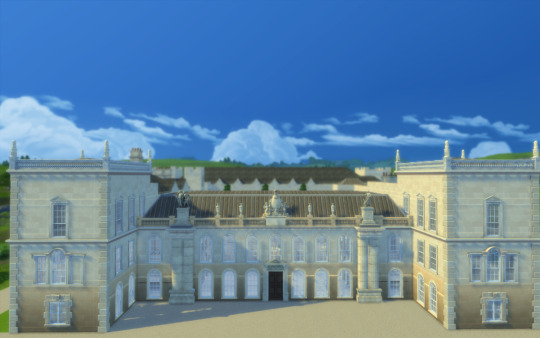

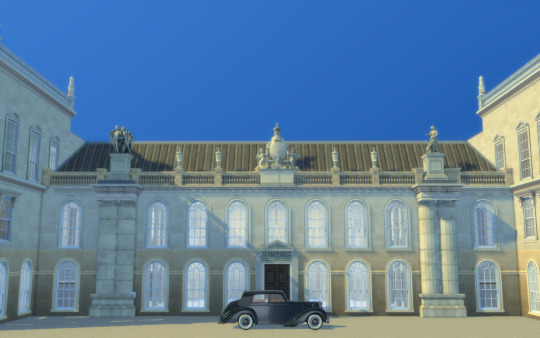
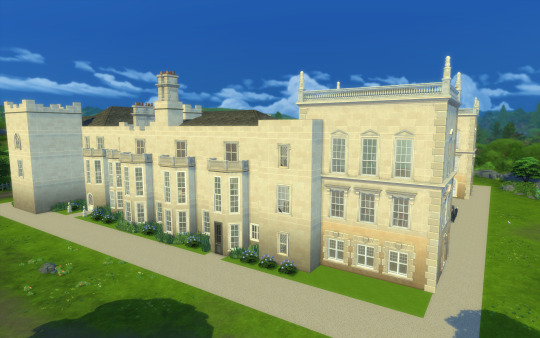
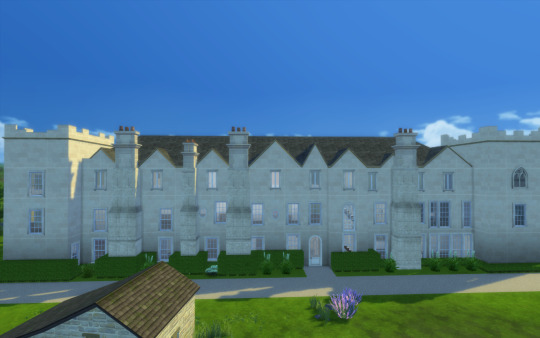
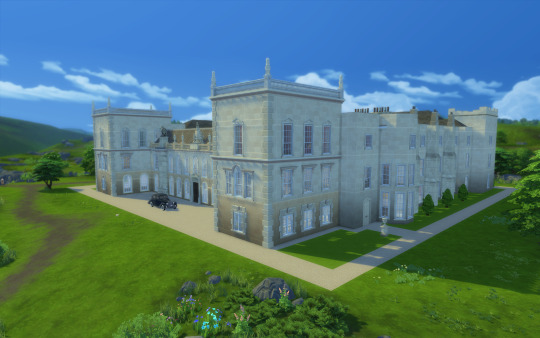
Grimsthorpe Castle
Hi guys!!
I'm sharing another grand english state!
House History: The building was originally a small castle on the crest of a ridge on the road inland from the Lincolnshire fen edge towards the Great North Road. It is said to have been begun by Gilbert de Gant, Earl of Lincoln in the early 13th century. However, he was the first and last in this creation of the Earldom of Lincoln and he died in 1156. Gilbert's heyday was the peak time of castle building in England, during the Anarchy. It is quite possible that the castle was built around 1140. However, the tower at the south-east corner of the present building is usually said to have been part of the original castle and it is known as King John's Tower. The naming of King John's tower seems to have led to a misattribution of the castle's origin to his time.
Gilbert de Gant spent much of his life in the power of the Earl of Chester and Grimsthorpe is likely to have fallen into his hands in 1156 when Gilbert died, though the title 'Earl of Lincoln' reverted to the crown. In the next creation of the earldom, in 1217, it was Ranulph de Blondeville, 4th Earl of Chester (1172–1232) who was ennobled with it. It seems that the title, if not the property was in the hands of King John during his reign; hence perhaps, the name of the tower.
During the last years of the Plantagenet kings of England, it was in the hands of Lord Lovell. He was a prominent supporter of Richard III. After Henry VII came to the throne, Lovell supported a rebellion to restore the earlier royal dynasty. The rebellion failed and Lovell's property was taken confiscated and given to a supporter of the Tudor Dynasty.[2]
The Tudor period
This grant by Henry VIII, Henry Tudor's son, to the 11th Baron Willoughby de Eresby was made in 1516, together with the hand in marriage of Maria de Salinas, a Spanish lady-in-waiting to Queen Catherine of Aragon. Their daughter Katherine inherited the title and estate on the death of her father in 1526, when she was aged just seven. In 1533, she became the fourth wife of Charles Brandon, 1st Duke of Suffolk, a close ally of Henry VIII. In 1539, Henry VIII granted Charles Suffolk the lands of the nearby suppressed Vaudey Abbey, founded in 1147, and he used its stone as building material for his new house. Suffolk set about extending and rebuilding his wife's house, and in only eighteen months it was ready for a visit in 1541 by King Henry, on his way to York to meet his nephew, James V of Scotland. In 1551, James's widow Mary of Guise also stayed at Grimsthorpe. The house stands on glacial till and it seems that the additions were hastily constructed. Substantial repairs were required later owing to the poor state of the foundations, but much of this Tudor house can still be seen today.
During Mary's reign the castle's owners, Katherine Brandon, Duchess of Suffolk (née Willoughby) and her second husband, Richard Bertie, were forced to leave it owing to their Anglican views. On Elizabeth's succeeding to the throne, they returned with their daughter, Susan, later Countess of Kent and their new son Peregrine, later the 13th Baron. He became a soldier and spent much of his time away from Grimsthorpe.
The Vanbrugh building
By 1707, when Grimsthorpe was illustrated in Britannia Illustrata, the 15th Baron Willoughby de Eresby and 3rd Earl Lindsey had rebuilt the north front of Grimsthorpe in the classical style. However, in 1715, Robert Bertie, the 16th Baron Willoughby de Eresby, employed Sir John Vanbrugh to design a Baroque front to the house to celebrate his ennoblement as the first Duke of Ancaster and Kesteven. It is Vanbrugh's last masterpiece. He also prepared designs for the reconstruction of the other three ranges of the house, but they were not carried out. His proposed elevation for the south front was in the Palladian style, which was just coming into fashion, and is quite different from all of his built designs.
The North Front of Grimsthorpe as rebuilt by Vanbrugh, drawn in 1819. Vanbrugh's Stone Hall occupies the space between the columns on both floors.
Inside, the Vanbrugh hall is monumental with stone arcades all around at two levels. Arcaded screens at each end of the hall separate the hall from staircases, much like those at Audley End House and Castle Howard. The staircase is behind the hall screen and leads to the staterooms on the first floor. The State Dining Room occupies Vanbrugh's north-east tower, with its painted ceiling lit by a Venetian window. It contains the throne used by George IV at his Coronation Banquet, and a Regency giltwood throne and footstool used by Queen Victoria in the old House of Lords. There is also a walnut and parcel gilt chair and footstool made for the use of George III at Westminster. The King James and State Drawing Rooms have been redecorated over the centuries, and contain portraits by Reynolds and Van Dyck, European furniture, and yellow Soho Tapestries woven by Joshua Morris around 1730. The South Corridor contains thrones used by Prince Albert and Edward VII, as well as the desk on which Queen Victoria signed her coronation oath. A series of rooms follows in the Tudor east range, with recessed oriel windows and ornate ceilings. The Chinese drawing room has a splendidly rich ceiling and an 18th-century fan-vaulted oriel window. The walls are hung with Chinese wallpaper depicting birds amidst bamboo. The chapel is magnificent with superb 17th-century plasterwork.
More history: https://en.wikipedia.org/wiki/Grimsthorpe_Castle
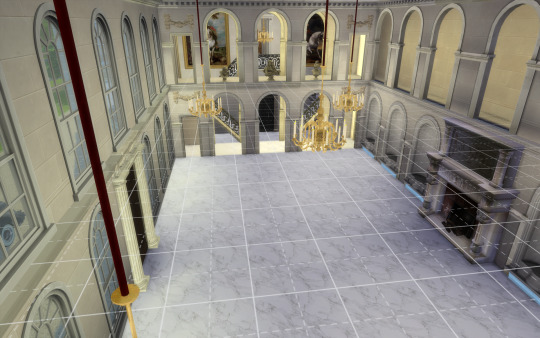
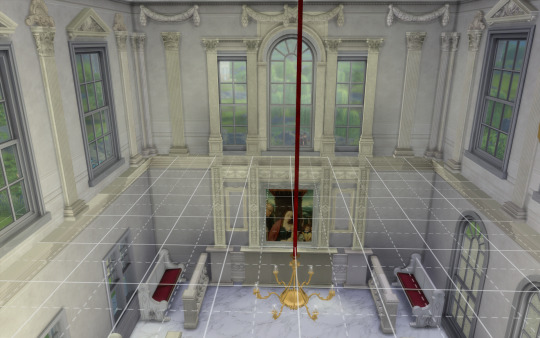
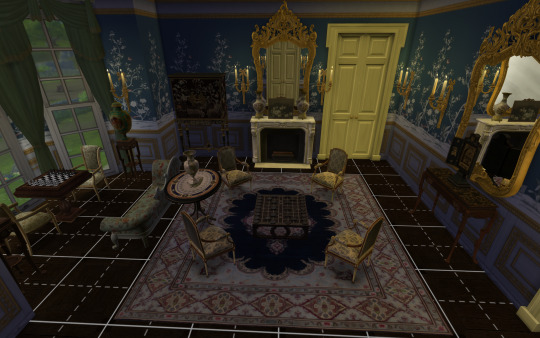
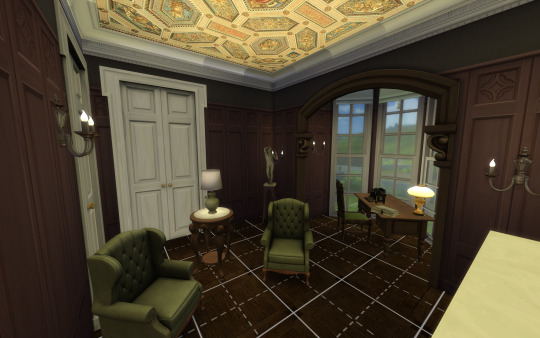
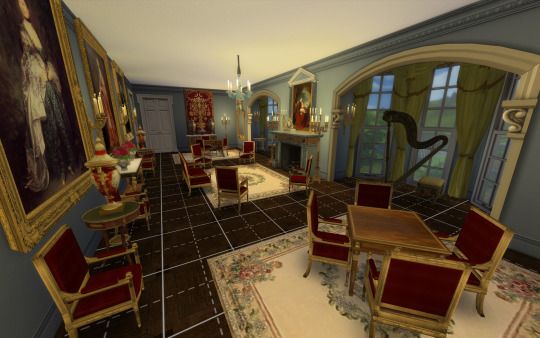
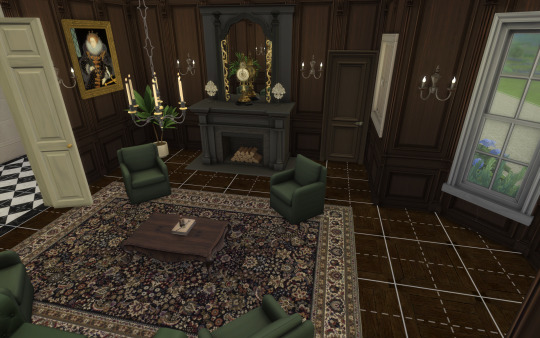
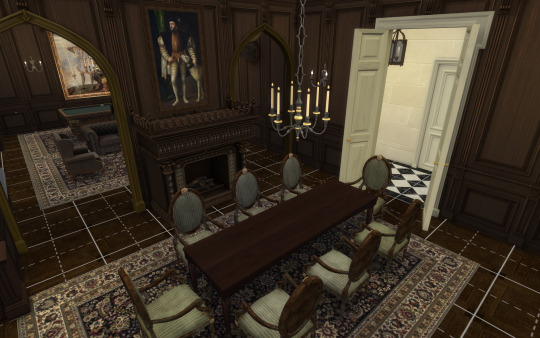
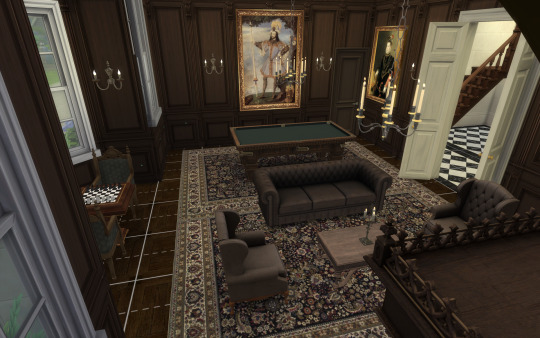
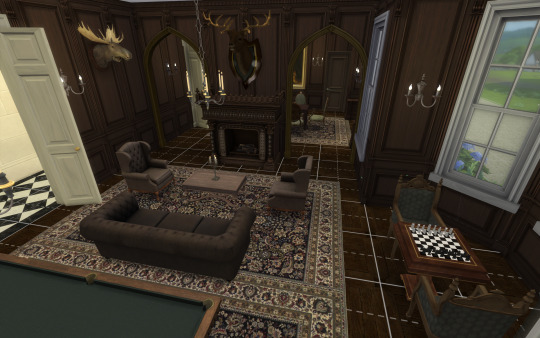

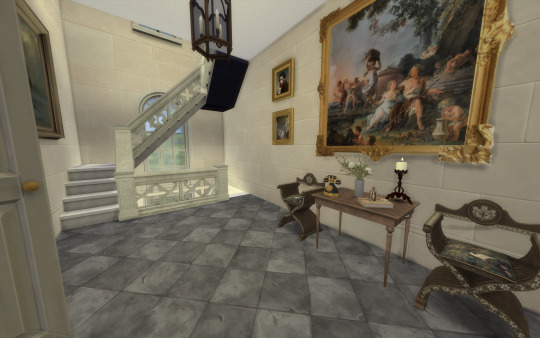
This house fits a 64x64 lot and features several impressive rooms, more than 29 bedrooms, a servants hall and several state rooms!
I only decored some of the main rooms, for you to have a glimpse of the distribution. The rest is up to you, as I have stated that I do not like interiors :P
Be warned: I did not have the floor plan for the tudor rooms, thus, the distribution is based on my own decision and can not fit the real house :P.
You will need the usual CC I use: all of Felixandre, The Jim, SYB, Anachrosims, Regal Sims, TGS, The Golden Sanctuary, Dndr recolors, etc.
Please enjoy, comment if you like it and share pictures with me if you use my creations!
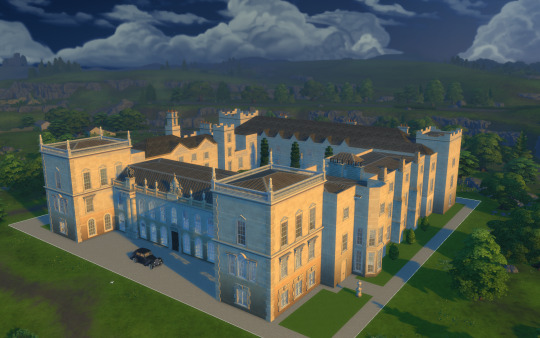






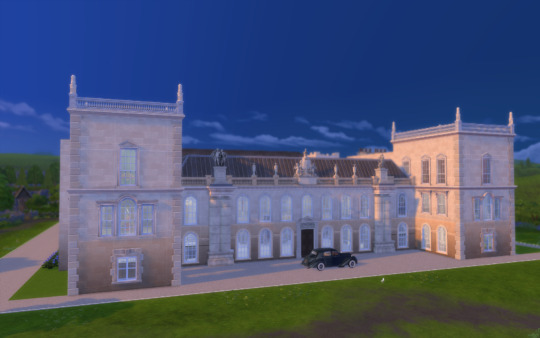
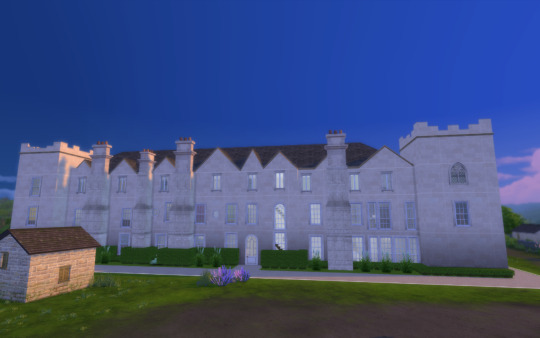
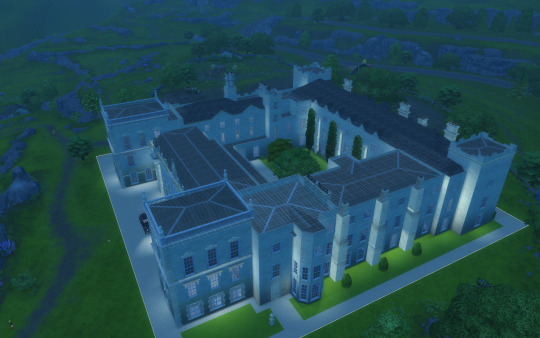
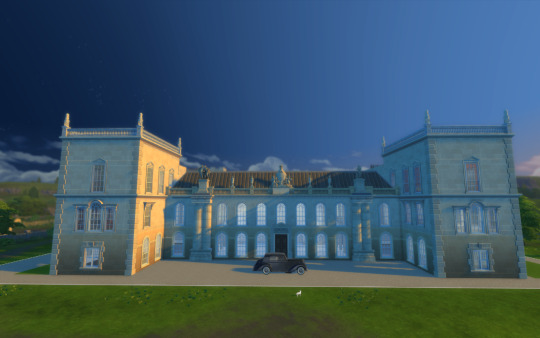
DOWNLOAD (Early acces: June 30) https://www.patreon.com/posts/grimsthorpe-101891128
#sims 4 architecture#sims 4 build#sims4#sims4play#sims 4 screenshots#sims 4 historical#sims4building#sims4palace#sims 4 royalty#ts4 download#ts4#ts4 gameplay#ts4 simblr#ts4cc#ts4 legacy#sims 4 gameplay#sims 4 legacy#sims 4 cc#thesims4#sims 4#the sims 4#sims 4 aesthetic#ts4 cc#english manor
41 notes
·
View notes
Text
In case anyone is interested, here are some of the historical ships I am more than willing to write:
HOUSE OF TUDOR:
-Henry VII & Elizabeth of York.
-Arthur Tudor & Catherine of Aragon.
-Mary Tudor & Louis XII // Charles Brandon, 1st Duke of Suffolk.
(And no, I would rather not receive any Henry VIII related stuff)
HOUSE OF HAPSBURG:
-Maximilian I & Mary of Burgundy // Bianca Maria Sforza (pretty please, ask me to write about this two).
-Charles V & Isabella of Portugal.
HOUSE OF BURGUNDY - VALOIS:
-Philip the Good & Isabella of Portugal.
-Charles Martin (Charles “the Bold”) & Isabelle de Bourbon // Margaret of York.
HOUSE OF AVIS:
-Manuel I & Maria of Aragon.
HOUSE OF YORK:
-Richard of Conisburgh & Anne Mortimer.
-Richard of York & Cecily Neville.
-George of Clarence & Isabel Neville.
HOUSE OF LANCASTER:
-Henry VI & Catherine of France.
-Henry VII & Margaret of Anjou.
OTHERS:
-Matthias Corvinus & Beatrice of Naples.
-Yolande of France & Amadeo IX of Savoy.
-Anne of Brittany & Maximilian I // Louis XII
( This may interest you @catherinemybeloved / @dickon777 )
12 notes
·
View notes
Text

Mary I's Fight For The Throne
3rd July - Mary warned by a friend
Mary is deep in preparations. She has caused "great provisions to be made in the country about Hunsdon" 1 and frequently sends Robert Rochester to the Imperial ambassador to share her plans and learn of the ever changing situation.
By this point Mary and her closest household staff have already decided "it will be wiser for her to retire to her house of Framlingham" 2, the very castle Edward VI granted her mere months ago. An escape route is being planned to the first base at Kenninghall, while Northumberland behaves "courteously towards the Princess, as if nothing were about to happen". 3 Mary too, is outwardly appearing "obedient, and to seem not only to harbour no suspicions of the Duke, but to have confidence in him." 4
In reality, Mary has "confidence in her friends in Norfolk" 5, despite them not being near court.
Her preparations are interrupted by a friend who tells her that Edward has appointed "as true heir to the Crown, after his death Suffolk's eldest daughter [Jane Grey], who has married my Lord Guilford, son of the Duke of Northumberland."6 Mary has been disinherited due to religious grounds.
Her friend is not named in any contemporary source. Many depictions feature Nicholas Throckmorton as the friend, as he claimed to be the one who informed Mary of Edward's death. However, in his own words that was later via her goldsmith, and never proven.
Nevertheless, with the new knowledge that Edward has named Jane Grey as his successor to the crown, and that "he will die suddenly, and no one can foretell whether he will live an hour longer" 7 Mary decides tomorrow she will leave Hunsdon.
Meanwhile...
Six warships have been fitted out and sailed to Margate. 8 These are commanded by Sir Richard Brooke 9, and include The Greyhound 10, whose captain Gilbert Grice is a servant of the Duke of Northumberland and has been paid £20 in advance of his service. 11
The Duke of Northumberland has 500 men wearing his livery, and the Duke of Suffolk 300. 12
Sources:
1. A Collection of State Papers relating to Affairs In the Reigns of King Henry VIII, King Edward VI, Queen Mary and Queen Elizabeth From the year 1542 to 1570
2. Spanish State Papers, 4th July 1553
3. Spanish State Papers, 4th July 1553
4. Spanish State Papers, 20th July 1553
5. Spanish State Papers, 4th July 1553
6. Spanish State Papers, 4th July 1553
7. Spanish State Papers, 4th July 1553
8. Spanish State Papers, 4th July 1553
9. Vita Mariae Angliae Reginae of Robert Wingfield
10. The Navy of Edward VI and Mary I
11. The Navy of Edward VI and Mary I
12. Spanish State Papers, 4th July 1553
8 notes
·
View notes
Text
Rough date timeline of Henry VI part 1 because that's how my day is going so far:
ACT 1
Scene 1: Henry V's funeral, which we know happened November 7, 1422.
Scene 2: The introduction of Joan la Pucelle, which historically happened in 1428. Six years have passed.
Scene 3: Gloster gets barred from the Tower of London, and he and Winchester are so at each other that somebody calls the cops. I can't find evidence of this being a real incident.
Scenes 4-6: Seige of Orleans, 1428-29. The French artillery's aim is getting better and Salisbury is killed. The English find out about Joan la Pucelle, who is on her way to lift the seige. Talbot is said to have been recently exchanged for a French prisoner, but this does not make sense.
ACT 2
Scenes 1-3: The English attack Orleans again to avenge Salisbury. Talbot meets/is taken prisoner by the Countess of Aubergne. (He was a French prisoner from 1429-33, but this isn't how he was taken.) Presumably this is why the French are able to break the seige.
Scene 4: Rose-picking in the garden scene. Did not happen, but I would put it in the summer of 1429, making Richard Duke of York not quite 18.
Scene 5: Edmund Mortimer shows up, explains some family history, and then dies. This didn't happen but that is a separate post entirely.
ACT 3
Scene 1: Fighting breaks out in Parliament courtesy of Gloster and Winchester. Henry VI has speaking lines for the first time, implying that it is at least November 1429, and he is about 8. Gloster suggests that Henry VI be crowned in France.
Scene 2: Bedford dies of illness while the French unsuccessfully attack Rouen. This would make it 1435, except Henry VI has recently arrived in France to be crowned, so it is probably 1430.
Scene 3: The French plot revenge for Rouen and Burgundy switches sides. It is now simultaneously 1435.
Scene 4: The English are in Paris, Talbot is made Earl of Shrewsbury (1442).
ACT 4
Scene 1: Henry VI is crowned in Paris (1431). He tries to "both sides" Somerset and York while putting on a red rose badge, but he's only 10 so let's give him some slack.
Scenes 2-4: Talbot and his son are killed fighting near Bordeaux while Somerset and York argue about whether or not to send reinforcements from elsewhere in Gascony. This historically happened in 1453, when Somerset and York were back in England.
ACT 5
Scene 1: Henry VI and Gloster discuss marriage to a daughter of the earl of Armagnac, so it's about 1442. Henry thinks he's too young (21?), but sends a gift to anyway.
Scenes 2-3: York captures Joan la Pucelle. Suffolk becomes soggily besotted with Margaret d'Anjou and negotiates her marriage to Henry VI. None of this happened, but Margaret's marriage negotiations began around 1444.
Scene 4: Speedrun of Joan la Pucelle's trial, 1431. Charles agrees to be Henry's subject if the English leave, which did not happen.
Scene 5: Suffolk and Winchester successfully argue for Margaret d'Anjou as Henry VI's bride, ending the play in 1444.
#shakespeare#wars of the roses#henry vi#richard duke of york#garen what are you doing#henry vi part 1#shakespearean timelines#edmund mortimer#Margaret d'Anjou was a toddler when Joan of Arc was executed#why are they in the same scene as teenagers
4 notes
·
View notes
Note
I don't know Henry VI very well, so he really does nothing? Margaret of Anjou took the place of the king, and her husband was just a puppet?
The answer to this is somewhat complicated because there's a split between the historians (K. B. MacFarlane, John Watts) who see Henry VI as incapable of ever ruling in his own right and the country was governed by others (the minority council, Suffolk, Somerset, Margaret and ultimately York) and the historians (Bertram Woolf, Ralph A. Griffiths) who see Henry VI as ruling in his own right for a stretch of time, albeit as a king who was lacking in judgement though they disagree on when he began ruling on his own. Personally, I think the arguments put forward by Griffiths and Woolf are the most convincing - that there was a stretch of time where Henry was ruling in his own right.
There's also the problem of looking back at Margaret of Anjou through the layers of Yorkist and Tudor narratives that sought to denigrate Margaret and portrayed her as an ambitious woman who subverted the natural order and would not submit to her husband as she ought to, often depicting Henry as a hapless puppet or long-suffering saint. We also know that Margaret remained at liberty when Richard, Duke of York and, later, Edward IV had custody of Henry VI, and was the active threat to their regimes. It was to their benefit to present Margaret as an agent of her own will, not Henry's - especially York, who was presenting himself as a loyal subject forced to rebel to save England from the evils of Henry's bad advisors and later had probably forced Henry disinherit his son and name York and his sons as his heirs. There is some evidence that Henry and Margaret were working together. Apparently there was a special token that only she and Henry knew so she would know if the messages came from Henry himself or were an attempt by the Yorkists to trick her into returning and placing herself and their son into Yorkist hands. This hardly suggests Henry was a hapless puppet who was controlled by his wife or whoever had custody of him, but rather supported Margaret's actions and resisted Yorkist rule in one of a few ways open to him.
#ask#anon#henry vi#margaret of anjou#honestly the image of henry as a hapless puppet and margaret as his puppet master is based very much in#accepting yorkist propaganda at face value and narratives of misogyny and ableism also accepted at face value
28 notes
·
View notes
Note
24 and 25 for the history ask?
24: Who do you consider to be one of the most underrated historical figures?
edward vi. henry vii and mary i are rightfully recognised and understood as similarly underrated in comparison to their successors, but they do have their advocates - unlike edward vi. i've encountered a lot of tudor enthusiasts, and nobody ever lists edward as their favourite tudor or favourite historical figure. of course, he died as a child and spent a good half of his reign with limited input into how he ruled, but in his short life he achieved a remarkable amount of change, plenty of which was his own work.
edward's legacy is hugely unfair. he's remembered, for the most part, as a sickly and weak child overpowered by the cruelty of his regents. but this is, in my opinion, a terrible way to view him. he was powerful. he was intelligent. he was raised to rule. he managed to handle his uncle kidnapping him; he helped shape what would have been the future of english protestantism; he began trying to solve the huge amounts of debt that his father and uncle had left him in. the main reason he is not remembered as an efficient king with a powerful and skilled advisor by his side (john dudley may not have been the most consistent person around, but i think his legacy also got fucked over by edward's untimely death) is that he died young. had he lived, he might have fathered an heir, finally secured the tudor succession (a problem which remained essentially unsolved across the entire period), fully established a church of england, reduced the financial problems of henry viii, and perhaps become involved with colonialism across the seas. (not that that's a good thing, but elizabeth i isn't exactly shunned for her involvement in ireland...)
and most of all, edward was human. he was a teenager with his own thoughts and feelings, ranging from his turbulent and tragic relationship with his sister, mary, to his grief over the death of his mother. he was orphaned at the age of nine. two of his uncles were beheaded when he was only eleven and fourteen respectively. he was overcome with sorrow when his friends, the dukes of suffolk, died. he once wrote of mary: 'i love you most.' but at christmas in 1550, they got into a row and made each other cry because they couldn't reconcile their religious beliefs - mary refused to bow to edward's religious changes, and edward was frustrated that mary insisted he was too young to know his own beliefs. he was close friends with lady jane grey, whom he later tried to make his heir. and he was fifteen! he died slowly and painfully, over a period of six months, and he was a teenager who knew that his entire life's work might be undone by his sister. he was stubborn, he was clever, he was deeply religious - all traits for which his sisters and father are well-known, but edward is denied. i want a proper drama focusing on edward's life, and NOT his annoying uncle or elizabeth, stat.
i was going to say something about margaret pole and arthur plantagenet here, but i got sidelined by my love for edward here. arthur was the illegitimate son of edward iv (who, funnily enough, died in the tower of london), and margaret was the daughter of george, duke of clarence, and niece of edward iv. neither of them were particularly important in edward iv or richard iii's reigns, but they later became much more relevant in the tudor era, as relatives of elizabeth of york and then henry viii. under henry viii, arthur was viscount lisle and lord deputy of calais - oddly enough, after his death, his title passed to john dudley, who was his stepson. margaret was mary i's governess, and her family remained staunch supporters of katherine of aragon. despite refusing to accept mary as his heir, henry apparently considered women a legitimate threat to his rule, as he executed margaret in 1541. earlier, he also arrested arthur. arthur was supposed to be released, but he died a few days after being freed, probably from a heart attack. they're the real last plantagenets.
i'll stop there, else this post will end up miles long.
25: Who is the most overrated historical figure, in your opinion?
stalin. elizabeth i. other people who weren't involved in colonialism, probably. oh yes! anne boleyn. we have all heard of anne boleyn, we get it, she was a person who existed. the actual woman anne boleyn seems really interesting, but unfortunately it gets buried under leagues of people more interested in either her romance with henry viii (boring) or people who simply wish to one-up those who aren't interested in her specific area of history. i am genuinely fascinated by henry viii, but i'm exhausted by the constant emphasis on anne boleyn this, elizabeth i that. i'm not interested in them!! i don't care!! but they're everywhere and fans of anne boleyn seem to feel oppressed for caring about an incredibly popular historical figure. not that anne wasn't treated with a lot of cruelty by henry viii and a lot of catholics both at the time and after the fact, but is there any historical figure except maybe her daughter who saturates all things tudor? i doubt it
(link)
18 notes
·
View notes
Text
Richard's charge at Bosworth, according to Edward Hall's chronicle.
...And being inflamed with ire and vexed with outragious malice, he pit his spurres to his horse and rose out of the dyde of y range of his battaile, leyung auntgardes fighting and like a hungry lion ran with spere in rest towards him. Therle of Richmonde perceyued wel the king furiusly commying towards him, and by cause the hole hope of his welth and purpose was to be determined by battaill, he gladly proferred to encoutre with him body to body and man to man. Kyng Rychard set on so sharpely at thefirst Brout y he ouerthew therles standarde, and slew Sir William Brandon, his standarde bearer(which was father to Sir Charles Brandon by kynge Henry VIII. created duke of Suffolke) and marched hand to hand w sir Ihon Cheinye, a man of great force and strenght which would haue resisted him, and the said Ihon was by him manfully ouerthrowen, and so he making open passage by dent of swerde as he went foward, therle of Richmond with stode his violence and kept him at the swerdes poincte without auantage longer than his companions other thought or iudged, which beying almost in dispaire of victorie, were sodainly recomforted by Sir William Stanley, whiche came to succours with III. thousand tall men, at which very instant kyge Richardes men were dryuen back and fledde, and he himself manfully fyghtynge in the mydell of his enemies was slayne and brought to his death as he worthely had deserued.
Edward Hall's Chronicle was first published in 1548, admitably many decades after Bosworth(1485). But interestingly, not just Vergil describes Henry VII withstanding brunt of Richard's charge for at least a while...
Not all details are same as in my previous post about battle of Bosworth(because i tried to find more contemporary sources) but it is very interesting to hear what more common people(not noblemen and courtiers) thought happened in Bosworth.
If anybody would wish to read in Hall's chronicle, it's online!
And here is the link:
24 notes
·
View notes
Text
"Margaret (of York, Duchess of Burgundy) left Bruges on 24 June and was in England for more than three months. She travelled with a large retinue headed by Guillaume de Baume and the embassy included two officials who were well-known to her, Thomas Plaines and Jean Gros, the treasurer of the Order of the Golden Fleece. She received aides from the Estates to cover her expenses with the Hainault Estates contributing 4,000 livres. Her mission had several goals, but the immediate need was to obtain some military help in the form of English archers to reinforce Maximilian’s hard pressed armies. ... King Edward sent Sir Edward Woodville, the Queen’s younger brother, aboard the royal ship ‘Falcon’ to bring his sister across the Channel. It was twelve years since she had sailed to her marriage. Sir Edward had been part of her marriage party and he had won the honours in the famous joust of the Golden Tree. This time Margaret took the shorter route from Calais to Gravesend, where she was received by Sir John Weston, the Prior of the Knights of St John. She then transferred to a royal barge which had been sent to bring her up the Thames to London. The barge was specially refitted for the occasion. The master and the twenty-four oarsmen had been supplied with new liveries in the Yorkist colours of murrey and blue with white roses embroidered on their jackets. The knights and squires who formed the escort of honour wore fine black velvet jackets which were decorated with a pattern of silver and purple. Two residences had been prepared for Margaret’s use, the palace at Greenwich where she had spent so much time before her marriage, and the London house of Coldharbour near her mother’s home at Baynard’s Castle. New beds with red and green hangings had been sent up to the Coldharbour house and the finest bedlinens and coverlets had been ordered. Curtains, screens and tapestries were provided for both the houses, including a piece of arras which depicted the story of Paris and Helen. For her travel during her stay in England, Margaret was sent ten ‘hobbeys and palfreys’ all newly harnessed and caparisoned in rich saddle cloths. The King encouraged everyone to be generous towards his sister and used ‘right large language’ with the Archbishop of Canterbury who failed to offer Margaret a gift. His own final present to his sister was a luxurious pillion saddle in blue and violet cloth of gold, fringed with ‘Venetian gold’ thread.
While she was in England, Margaret renewed her contacts with all her old friends and family. She was received by the Queen and introduced to her royal nephews and nieces. Her youngest brother Richard, Duke of Gloucester, who was busy dealing with Scottish incursions in the north, made time to come south to see his sister, and the King gave a state banquet at Greenwich in honour of Margaret and their mother, the old Duchess Cecily. It was also attended by Margaret’s sister Elizabeth, Duchess of Suffolk. It seems that Margaret admired the wine, for on the day after the banquet, Edward sent her ‘a pipe of our wine’ valued at 36s 8d. As well as enjoying the company of her living family, Margaret could not have failed to remember all her dead relations. It was perhaps with a chantry in mind that she persuaded Edward to introduce the reformed Order of the Observant Friars into England. Soon after her departure the King sent for the Vicar-General of the Order and offered him a site for their new monastery near to the palace of Greenwich. Building began in 1482 and the abbey chapel was dedicated to the Holy Cross. Was the dedication in honour of Margaret, and does it provide further evidence of her connection with Waltham Abbey? ... Well satisfied that the negotiations were at last completed, Margaret prepared to leave London. She paid a farewell visit to the city where she was presented with a purse containing £100. She then set off for the coast accompanied by her brother Edward who had decided to see her on her way. ... The Dowager passed a week in Kent visiting the shrine of St Thomas à Becket and staying on the private estates of Anthony Woodville, Lord Rivers. These two bibliophiles must have had much in common especially now that Rivers was the patron of Margaret’s former protégé, William Caxton. No doubt she was shown Woodville’s translation of the ‘Dictes and Sayings of the Philosophers’ which was one of the first books printed on Caxton’s press at Westminster. With the King still in attendance, Margaret finally left for Dover, where the ‘Falcon’ waited to take her back to Calais. Edward seemed to be genuinely sad to see her departure and he wrote to Maximilian on 22 September announcing the return of his ‘well-beloved sister’. She left behind her in England Jacques de la Villeon, who was to act as an agent for the Burgundian ally, the Duke of Brittany."
Christine Weightman, "Margaret of York: The Diabolical Duchess"
#historicwomendaily#margaret of york duchess of burgundy#margaret of york#margaret of burgundy#15th century#english history#my post#everyone knows about the politics. let's focus on the personal#also there's a misconception that she and edward were estranged after clarence's death#i really don't think that's true
20 notes
·
View notes
Note
Where there any ideological differences between the Lancastrians and Yorkists (both the families and their supports)?
The Wars of the Roses was largely a dynastic struggle over the throne and royal patronage, but there were roots in earlier political struggles during the reign of Henry VI between what we could call a "war party" faction and a "peace party" faction.
Broadly speaking, the "war party" faction was led by people like Richard Duke of York and Richard Neville, and they tended to favor a continuation of the Hundred Years War, an alliance with Burgundy, disapproval of the King's marriage and the Queen's overly-active role in government, more royal efforts to improve law and order, and a crackdown on rampant corruption and favoritism that saw royal land distributed to court favorites, sapping royal finances.
Broadly speaking, the "peace party" faction was led by Margaret d'Anjou and her favorites like Somerset and Stafford. They tended to favor an end to the Hundred Years War, an alliance with France, obviously they favored the king's marriage and the Queen's active role in government, and they generally blamed problems in royal government on York's rebellious factionalism and emphasized that the royal prerogatives ought not to be questioned.
However, a lot of that stuff fell by the wayside once the fighting started - England couldn't really fight a civil war and war with France at the same time, Suffolk was dead, and efforts to deal with law and order, corruption, and royal finances would all have to wait until the fighting died down after Towton, and then again after Tewkesbury.
52 notes
·
View notes
Text
Congratulations to today's champions!!
Be it known that these Competitors have triumphed on the Fourth Day of Contest of Round One!
Gawain [Dev Patel], The Green Knight (2021)

Defeats Matrim “Mat” Cauthon [Donal Finn], The Wheel of Time (2022) with 83.2% of the Vote
George, The Sheriff of Nottingham, Robin Hood: Prince of Thieves (1991)

Defeats Kili, The Hobbit Trilogy (2012-2014) with 50.8% of the Vote
Inigo Montoya [Mandy Patinkin], The Princess Bride (1987)

Defeats Lord Corlys Velaryon [Steve Toussaint], House of the Dragon (2022-) with 79.2% of the Vote
Xenk Yendar [Regé-Jean Page], Dungeons & Dragons: Honor Among Thieves (2023)

Defeats Thraxus Boorman [Amar Chadha-Patel], Willow (2022) with 73.7% of the Vote
Aragorn Elessar [Viggo Mortensen], The Lord of the Rings Trilogy (2001-2003)

Defeats Ahmad [Mahesh Jadu], Marco Polo (2014-2016) with 80% of the Vote
Prince John [Oscar Isaac], Robin Hood (2010)

Charles Brandon, Duke of Suffolk [Henry Cavill], The Tudors (2007-2010) with 67.1% of the Vote
Sandor "The Hound" Clegane, Game of Thrones (2011-2019)

Defeats “The Sherriff of Nottingham” [Peter Cushing], The Sword of Sherwood Forest (1960) with 59.9% of the Vote
Elrond Half-elven [Hugo Weaving], The Lord of the Rings Trilogy (2001-2003)

Defeats King Henry V Plantagenet [Laurence Olivier], Henry V (1944) with 72.2% of the Vote
Sultan Alauddin Khilji [Ranveer Singh], Padmavaat (2018)

Defeats King Richard II Plantagenet [Ben Whishaw], The Hollow Crown (2012-2016) with 63.2% of the Vote
Will Scarlett [Harry Lloyd], BBC’s Robin Hood (2006-2009)

Defeats Francesco de Pazzi [Matteo Martari], Medici (2016-2019) with 67.7% of the Vote
25 notes
·
View notes
Text
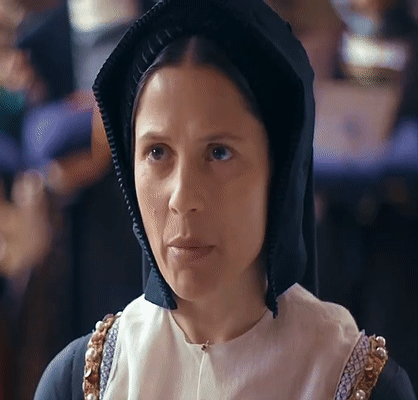

Family of Maria de Salinas, Lady Willoughby
Father: Juan de Salinas, nicknamed El Rico (The Rich), was a Spanish nobleman, wealthy merchant, banker, and secretary to Isabel, Princess of Portugal, in 1492 (daughter of the Catholic Monarchs).
Mother: Inés de Albornoz Tavira was a Spanish noblewoman of Portuguese descent, lady-in-waiting to Isabel, Princess of Portugal.
Siblings:
1- Inés de Albornoz traveled to England accompanying Katherine of Aragon as one of her maids-of-honor. She married to Juan Francisco Velez de Guevara of Stanyott, and returned to Spain after a few years living in England.
2- Juan de Salinas, Licentiate and Bachelor. Lived in Spain.
3- Francisco Alonso de Albornoz. Lived in Spain.
4- Teresa de Salinas, nun at the convent of Santa Clara in Vitoria, Basque Country, Spain.
5- Isabel de Albornoz, married to Ochoa de la Landa, banker of the court of the Catholic Monarchs.
Some of her siblings used their mother's surname, apparently a not uncommon practice in Spain. Her cousin Martín de Salinas El Joven was ambassador of Charles V.
Spouse: William Willoughby, 11th Baron Willoughby de Eresby, was an English nobleman and the largest landowner in Lincolnshire.
Children:
1- Henry, died in infancy.
2- Francis, died young.
3- Catherine inherited the barony after her father's death. She was the fourth wife of Charles Brandon, Duke of Suffolk. Her second husband was Richard Bertie, a member of her household. An outspoken supporter of the English Reformation, she were among the Marian exiles who left for the Continent. After her return to England lived at Grimsthorpe in Lincolnshire, and at court of Queen Elizabeth I. She had four children, Henry and Charles Brandon, and Susan and Peregrine Bertie.
15 notes
·
View notes